Employee settings and defaults used in generating Payroll Timecards

- Status
- Active - this Employee is accessible to process paycheques (timecards)
- Terminated - prohibits processing paycheques (timecards) for this Employee and allows ROE creation (see PAYROLL - Record of Employment)
- On Leave - might not require a Record of Employment
- Details tab
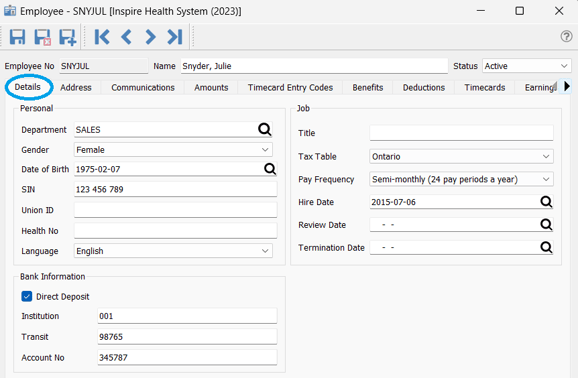
-
- Department
- Setup - Payroll text menu > Payroll Departments
- Department


-
-
- New Department
-
-
-
-
- click
 New (or open an existing Department and click
New (or open an existing Department and click  to Copy this Department into a new one)
to Copy this Department into a new one) - type a number in the Code field
- type a Description
- Accounts tab
- click
-
-
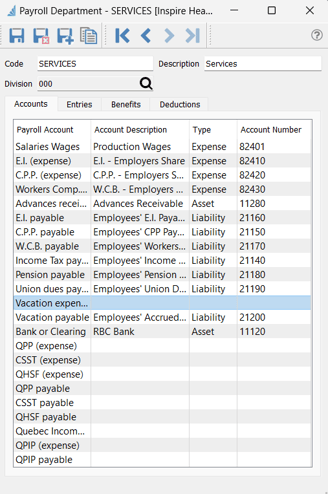
-
-
-
-
- click into the Account Number to browse for the GL Account that matches the corresponding Payroll Account item
- Entries tab - establish Timecard Entry Code defaults
- Benefits tab - establish any non-monetary amounts that extra tax will be charged on for Employees in this Department
- Deductions tab - establish any non-government deductions to use for Employees in this Department
-
-
-
-
-
 Edit Department
Edit Department
- select the existing Department Code and click
 Edit
Edit - option to change the Description
- option to click into the GL Account Number for any Payroll Account item and type or browse for the preferred GL Account
- select the existing Department Code and click
- select Sex
-
-
- enter or browse for Date of Birth which determines when CPP no longer calculates on timecards (between 18 and 70 years of age)
- enter SIN (Social Insurance Number)
- enter Union ID (if applicable)
- option to enter Health No
- accept English as Language or change to French
- if
 Direct Deposit is activated (see Payroll - Direct Deposit), complete the following:
Direct Deposit is activated (see Payroll - Direct Deposit), complete the following:
- employee’s bank Institution
- employee’s bank Transit
- employee’s bank Account No
-
- Title - enter Employee’s formal title (prints on the Record Of Employment)
- select provincial Tax Table depending on where the Employee resides
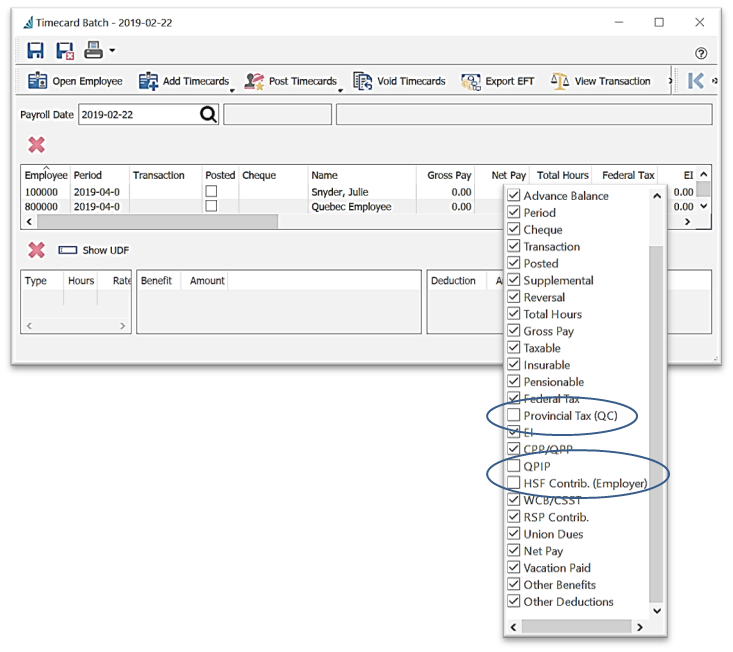
-
- select number of Periods this Employee is paid per year as established in Payroll Schedule
- Weekly (52 pay periods a year)
- Biweekly (26 or 27 pay periods a year)
- Semi-monthly (24 pay periods a year)
- Monthly (12 pay periods a year)
- 13 pay periods a year - every 4 weeks
- Quarterly (4 pay periods a year)
- Annually (1 pay period a year)
- enter or browse for Hire Date
- select number of Periods this Employee is paid per year as established in Payroll Schedule
-
- option to enter Review Date if this is to be tracked
- enter Termination Date for terminated Employees
- Address tab
-
- Validate Address if Avatax (US taxes) is Integrated
- enter any or all address fields
- enter Contacts Name / Phone / Fax or Cell / Email
- if phone is UK format, select the Country first
- select Contact Type (manage Contact Types: Edit > Company Settings > Company > Contact Types tab)
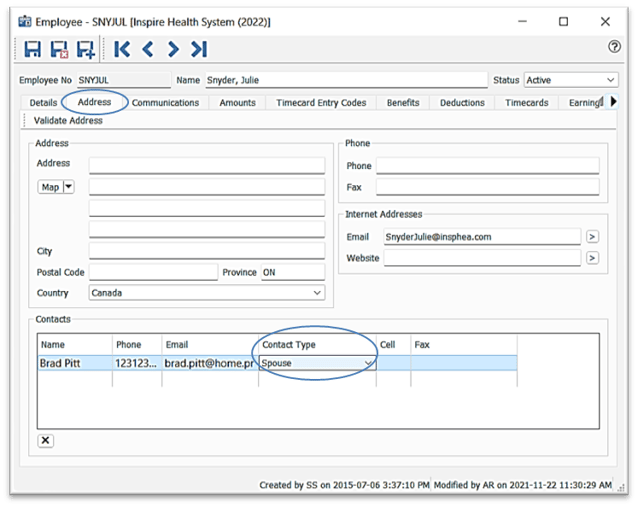
-
-
- Communications - see PAYROLL - Employee Communications
-
- Amounts tab

-
- Credits and exemptions
-
-
- Federal TD1 Claim (see also Payroll - Year End)
 Automatic with amount at zero will allow automatic calculation as provided by CRA Tax Tables (see also Payroll - Year End)
Automatic with amount at zero will allow automatic calculation as provided by CRA Tax Tables (see also Payroll - Year End)
- Federal TD1 Claim (see also Payroll - Year End)
-
-
-
-
- uncheck
 Automatic and fill in
Automatic and fill in  for manual calculation
for manual calculation
- uncheck
- Child care tax credit amount
- Alimony tax credit amount
-
-
-
-
- Remote residence tax credit amount
- Provincial TD1 Claim (see also Payroll - Year End)
 Automatic with amount at zero will allow automatic calculation as provided by CRA Tax Tables (for participating provinces only)
Automatic with amount at zero will allow automatic calculation as provided by CRA Tax Tables (for participating provinces only)
-
-
-
-
- uncheck
 Automatic and fill in
Automatic and fill in  for manual calculation
for manual calculation
- uncheck
-
 Tax Exempt (Claim Code E) - option to exempt this employee from tax deductions
Tax Exempt (Claim Code E) - option to exempt this employee from tax deductions
-
- Payments - these amounts are system tracked and will display in Timecards for this Employee
-
-
-
- Advance Balance option to enter an opening amount - this is updated automatically whenever Advance is used as a pay Type in a timecard, whether it be a positive or negative to increase or decrease the balance
- Vacation Owed - option to enter an opening amount on a new employee - tracks all amounts calculated on paycheques provided
 Retain Vacation is checked, and is reduced by all amounts paid out as Vacation pay Type on paycheques (timecards)
Retain Vacation is checked, and is reduced by all amounts paid out as Vacation pay Type on paycheques (timecards)
- Deductions and rates
-
-
-
- RSP / Pension - enter the amount by dollar amount or percentage, that is to be deducted from each paycheque for this Employee
- Union Dues - enter the amount (if applicable) for deduction on each paycheque
- Additional tax deduction (TD1) - if Employee has other non-taxed sources of income, they may elect to have extra tax taken for each paycheque (no decimals accepted)
- Estimated Pay* - for commission remunerated employees, the tax is pro-rated over 12 months based on this annual estimate to even out per-pay tax calculations (reduced by Estimated Expenses)
- to assist in deductions calculations, see the Days Since Last Pay field in the Timecard
-
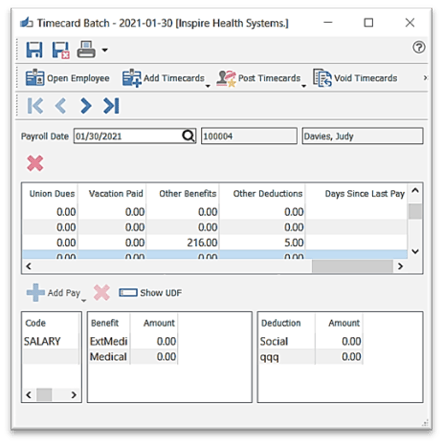
-
-
- Estimated Expenses* reduces the Estimated Pay for a net taxable annual earning, pro-rated over 12 months
-
-
-
- Employer EI Rate (Employment Insurance) Factor represents the employer’s portion of the Employment Insurance deducted from this Employee due to Canada Revenue Agency
- claim exemption from
 CPP (Canada Pension Plan) - Date of Birth will trigger an exemption automatically for anyone surpassing the regulatory exemption age
CPP (Canada Pension Plan) - Date of Birth will trigger an exemption automatically for anyone surpassing the regulatory exemption age
-
-
-
-
 EI (Employment Insurance)
EI (Employment Insurance) QPIP Quebec Parental Insurance Plan
QPIP Quebec Parental Insurance Plan
-
-
-
-
- WCB (Worker’s Compensation Board, also known as WSIB – Workplace Safety and Insurance Board)
- Rate - enter a rate to have Spire calculate the premiums for this Employee for each paycheque (timecard) - the GL Account this would be accumulated in is established in the Payroll Department list of accounts (see Department)
- Assessable - represents maximum assessable earnings for the current year - this is updated with each new Payroll tables update (see Payroll Year End) - check wsib.on.ca/ for the current year’s maximum
- Vacation Rate - establish the percentage that will be calculated to retain or release (pay out) per paycheque (timecard)
- WCB (Worker’s Compensation Board, also known as WSIB – Workplace Safety and Insurance Board)
-
-
-
-
-
 Retain Vacation
Retain Vacation
- checked - Spire will calculate and accrue (hold in a GL Account until paid out) the vacation pay amount based on the rate entered
- unchecked - Spire will calculate and add to the paycheque, the vacation pay amount based on the rate entered
- to pay out accrued vacation, choose Vacation pay Type in the Timecard

-
-
-
-
-
- Benefits reporting
- establish Dental benefits options for T4s

- not sure? Visit https://www.canada.ca/en/revenue-agency/services/child-family-benefits/dental-benefit.html
- establish Dental benefits options for T4s
- Benefits reporting
-
- Timecard Entry Codes tab - see Payroll - New Timecard Batch
- Benefits tab
- Benefit setup - Payroll Menu > Payroll Departments

-
-
- select Payroll Department

- select Payroll Department
-
-
-
- click
 Edit (or just double-click on the Department)
Edit (or just double-click on the Department) - select the Benefits tab
- click
-
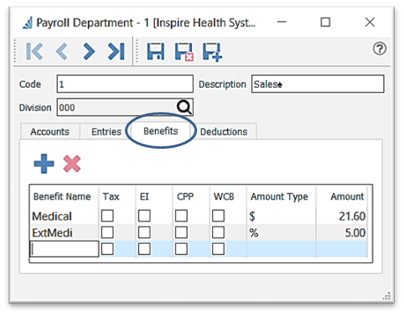
-
-
- click
 New
New - enter Benefit Name as it will appear in the Employee Benefits tab (ie Medical)
- determine whether this amount will have calculations on it for
 Tax /
Tax /  EI /
EI /  CPP /
CPP /  WCB (not sure? check cra-arc.gc.ca)
WCB (not sure? check cra-arc.gc.ca) - select Amount Type $ or %
- enter the Amount of the benefit claimed per paycheque (this can be changed for each Employee and each Timecard)
- click
- enter Benefits into Employee settings:
- Employee Benefits tab
- option to Use Defaults as established above in Benefit Setup or establish different Amounts and Tax / EI / CPP / WCB calculation rules
-
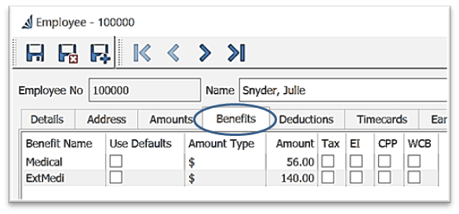
- Deductions tab - establish any non-government deductions, setup per payroll department
-
- Deduction setup - Payroll menu > Payroll Departments
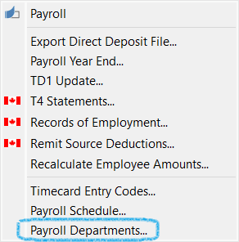
-
-
- select Payroll Department

- select Payroll Department
-
-
-
- click Edit (or just double-click on the Department)
- click New
- enter the Deduction Name as it will appear in the Employee Deductions tab (ie Social)
- enter the General Ledger Account Number that this Deduction will be accumulated in
-
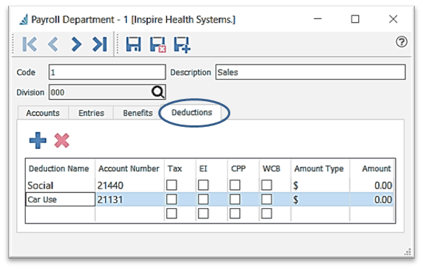
-
- determine whether this amount will have calculations on it for
 Tax /
Tax /  EI /
EI /
- determine whether this amount will have calculations on it for
-
-
- not sure? check cra-arc.gc.ca
-
-
- select Amount Type as $ or %
- enter the Amount that will be automatically deducted per paycheque (this can be changed for each Employee and each Timecard)
- Employee settings
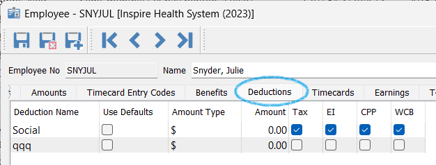
-
-
- Employee Deductions tab
- option to
 Use Defaults as established above in Deductions Setup or establish different Amounts and Tax / EI / CPP / WCB calculation rules
Use Defaults as established above in Deductions Setup or establish different Amounts and Tax / EI / CPP / WCB calculation rules
-
- Timecards tab
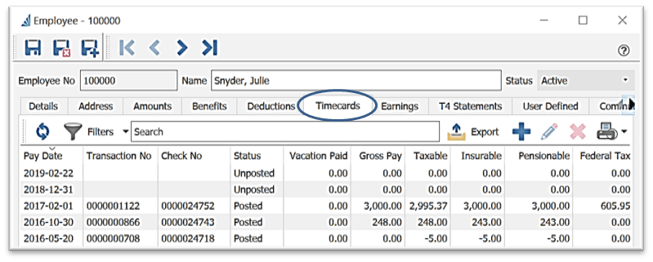
-
 Refresh to load any Timecards that may have been posted by another user since last refresh and that may not be displaying on this list
Refresh to load any Timecards that may have been posted by another user since last refresh and that may not be displaying on this list
-
-

 Filter / Search / Customize Timecards List - see Employee List Customization
Filter / Search / Customize Timecards List - see Employee List Customization -
 Export Employee Timecard(s) in Excel or CSV format - see Employees Export
Export Employee Timecard(s) in Excel or CSV format - see Employees Export  New Timecard Batch - see Payroll - New Timecard Batch
New Timecard Batch - see Payroll - New Timecard Batch
-
-
-
 Edit the selected Timecard to view or to add a supplementary Timecard, or to void a Timecard
Edit the selected Timecard to view or to add a supplementary Timecard, or to void a Timecard  Delete the selected Timecard (if it is not posted yet)
Delete the selected Timecard (if it is not posted yet) Print to select from available reports on the selected Timecard(s) - see Payroll - Reports
Print to select from available reports on the selected Timecard(s) - see Payroll - Reports
-
-
- Employee Timecards Tab Context Menu - right-click on any line to access
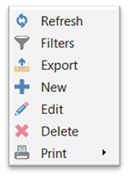
- Earnings tab displays This Year and Last Year Earnings, Withholdings, Deductions and Benefits for the current Employee
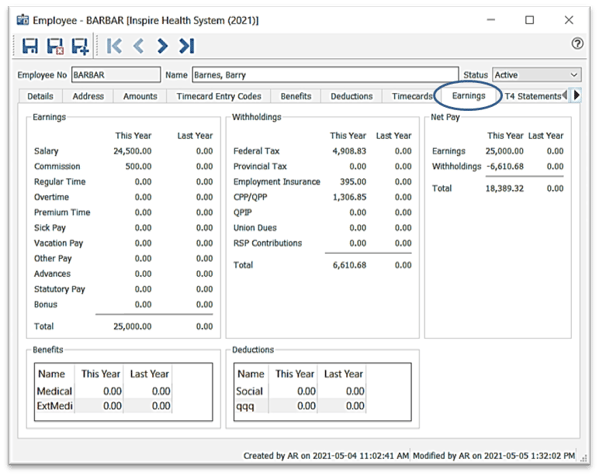
- T4 Statements tab displays the T4 for current employee that was previously generated (see also Payroll - Year End / T4s)

 Refresh to load any T4 Statements that may have been posted by another user since last refresh and that may not be displaying on this list
Refresh to load any T4 Statements that may have been posted by another user since last refresh and that may not be displaying on this list
-
-

 Filter / Search / Customize T4 Statements List - see Employee List Customization
Filter / Search / Customize T4 Statements List - see Employee List Customization -
 Export T4 Statement(s) in Excel or CSV format - see Employee Export
Export T4 Statement(s) in Excel or CSV format - see Employee Export  New T4 - see Payroll - Year End / T4s
New T4 - see Payroll - Year End / T4s
-
-
-
 Edit the selected T4 - see Payroll - Year End / T4s
Edit the selected T4 - see Payroll - Year End / T4s  Delete the selected Timecard (if it has not been Remitted yet)
Delete the selected Timecard (if it has not been Remitted yet) Print T4 or T4 Summary on the selected T4(s)
Print T4 or T4 Summary on the selected T4(s) Generate T4’s to create T4’s for the last Payroll Year
Generate T4’s to create T4’s for the last Payroll Year Mark Remitted to identify the selected T4 as having been sent to CRA
Mark Remitted to identify the selected T4 as having been sent to CRA Export for CRA to create the file to submit on the CRA website
Export for CRA to create the file to submit on the CRA website
-
-
- Employee T4 Statements Tab Context Menu - right-click on any line to access
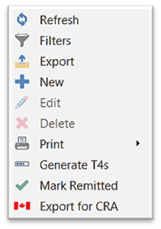
- User Defined Tab (see User Defined Fields)
-
- The User Defined Fields (UDF) allows you to add unlimited information fields that are not included in the default Spire program, for use in list Filters, Excel exports, and for setting into forms and reports
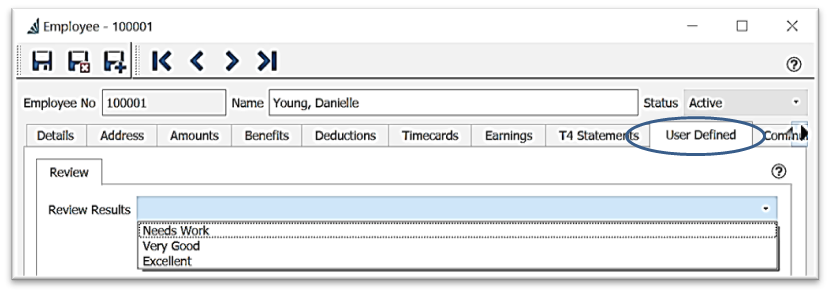
- The User Defined Fields (UDF) allows you to add unlimited information fields that are not included in the default Spire program, for use in list Filters, Excel exports, and for setting into forms and reports
.png?height=120&name=Gemini-Logic-Logo%20(1).png)